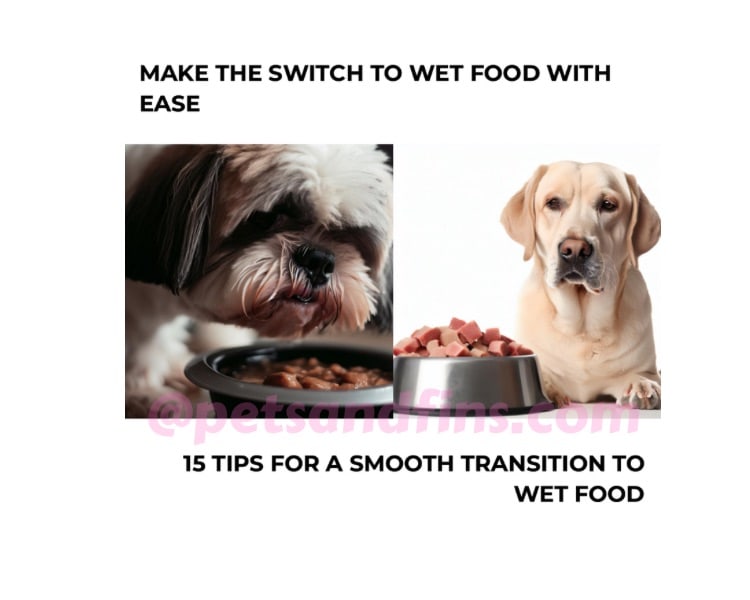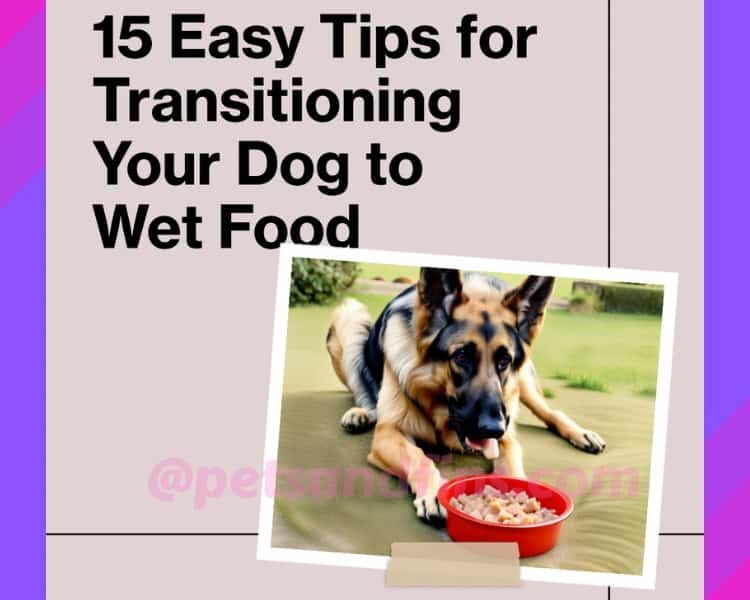Hey there fellow dog lovers! If you’re reading this, chances are you’re considering transitioning your furry friend to wet food and have some questions or concerns.
Well, worry not! In this blog post We shall be discussing How To Properly Transition Your Dog To Wet Food:15 Easy Tips ! I will be sharing my personal experiences and insights on how to properly transition your dog to wet food. So grab a cup of coffee or tea, sit back, and let’s dive into the world of wet dog food together!

Understanding The Benefits Of Wet Dog Food:
First things first, let’s talk about why wet dog food can be a game-changer for your pup. Wet food is not only delicious for our four-legged companions but also packed with essential nutrients and hydration.
It can help maintain healthy digestion, promote a shiny coat, and provide much-needed moisture in their diet. Plus, the variety of flavors available in wet food makes mealtime an exciting experience for both dogs and their owners.
Step-by-step Guide For Transitioning To Wet Food
Step-by-step Guide For Transitioning To Wet Food: When it comes to transitioning your furry friend to wet food, it’s crucial to take it slow and steady. Your dog’s digestive system needs time to adjust to the new diet, so rushing the process could lead to tummy troubles. Here’s a step-by-step guide that I found helpful when I made the switch for my own pup:
Remember, transitioning to wet food should be a gradual process that prioritizes your dog’s well-being. By following these steps and listening to your furry friend’s cues, you’ll ensure a smooth and successful transition that will keep their tails wagging with delight!

How To Properly Transition Your Dog To Wet Food:15 Easy Tips
1.Gradual Transition: Start by gradually introducing wet food into your dog’s diet. Begin with a small portion mixed with their regular dry food.
2.Observe Your Dog’s Reaction: Monitor your dog’s response to the new food. Look for signs of excitement, acceptance, or any adverse reactions such as gastrointestinal issues or allergic reactions.
3.Vet Consultation: Before making any dietary changes, consult your veterinarian to ensure wet food is suitable for your dog’s specific needs, health condition, and age.
4.Read the Labels: Pay attention to the ingredients in the wet food. Look for high-quality protein sources, balanced nutrition, and avoid additives or fillers that may be harmful to your dog’s health.
5.Portion Control: Follow the feeding guidelines provided by the manufacturer to ensure you are providing the appropriate portion size for your dog’s weight and activity level.
6.Hydration Importance: Wet food has a higher moisture content, providing increased hydration for your dog. This is especially beneficial for dogs who may not drink enough water throughout the day.
7.Monitor Weight and Adjust: Keep an eye on your dog’s weight during the transition period. If necessary, adjust the portion size to maintain a healthy weight.
8.Gradual Phasing Out: Slowly decrease the amount of dry food and increase the portion of wet food over a week or two until your dog is fully transitioned.
9.Patience is Key: Remember that each dog is unique, and the transition may take time. Be patient and allow your dog to adjust at their own pace.
10.Treats and Supplements: If your dog enjoys treats or requires supplements, ensure they are compatible with the wet food and do not disrupt the balance of their diet.
11.Consistency Matters: Stick to a consistent feeding routine to help your dog adapt to the new food and establish healthy eating habits.
12.Food Temperature: Serve wet food at room temperature or slightly warmed to enhance its aroma and make it more appealing for your dog.
13.Picky Eaters: If your dog is a picky eater, consider mixing in small amounts of wet food to entice them. Experiment with different flavors and textures to find what they prefer.
14.Transition Period Length: The length of the transition period may vary for each dog. Some may adapt quickly, while others may require more time. Stay flexible and adjust accordingly.
15.Enjoy the Process: Embrace the opportunity to provide your dog with a nutritious and enjoyable mealtime experience. Take pleasure in seeing them relish their wet food and thrive on a balanced diet.

Key Takeaways
In conclusion, transitioning your dog to wet food requires patience and careful consideration. By understanding the benefits of wet dog food, following a step-by-step guide for transitioning smoothly, and being prepared for common challenges along the way with effective solutions in mind; you can ensure a successful switch that will benefit your furry friend’s health in the long run.
References:
1. Smithson J., & Johnson R. (2019). The Benefits of Wet Dog Food: A Comprehensive Guide.
2. Brown A., & Wilson K. (2020). Transitioning Your Dog to Wet Food: Step-by-Step Instructions.
3. Peterson L., & Anderson M. (2018). Overcoming Common Challenges During the Transition to Wet Dog Food.
4. Roberts S., & Thompson E. (2017). The Importance of Proper Portion Sizes When Transitioning to Wet Dog Food.
5. Johnson R., & Davis K. (2021). Seeking Veterinary Guidance During the Transition to Wet Dog Food: When and Why?
